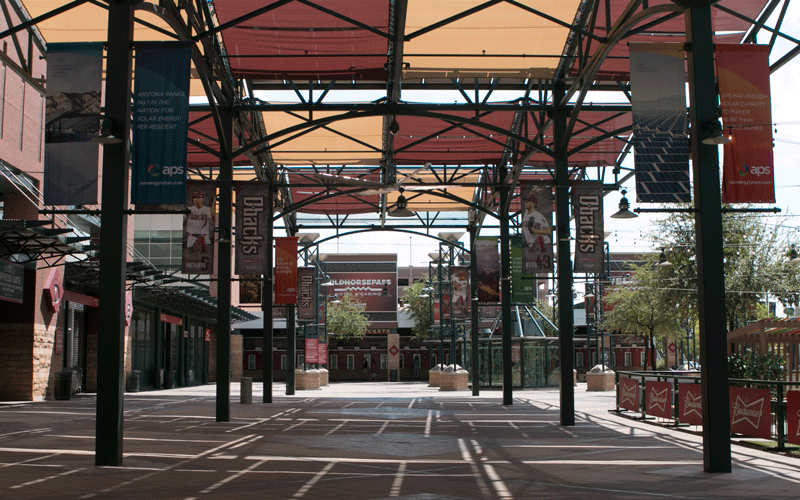The Diamondbacks are unhappy with the condition of Chase Field and have asked Maricopa County for the freedom to explore other options. The county, citing the 1996 facility use agreement between the two parties, denied their request and the two sides have taken their feud public.
A 2013 Maricopa County assessment found that Chase Field needs $187 million in upgrades. Now a dispute over both the scope of the upgrades and responsibility for their cost has the team considering the possibility of leaving the only home it has had since the franchise’s inaugural season in 1998.
County officials told the Diamondbacks the county cannot afford to pay for the upgrades or raise the funds for such a project, according to a letter Diamondbacks President and CEO Derrick Hall wrote to the county Thursday.
“It’s sad that we came up with a pretty good solution of let us just go out and look right now, and at the end of the day we may end up back here at Chase, which is where we prefer to be, but we need to see what’s out there before it’s too late,” Hall said at a Thursday evening news conference.
An hour before Hall spoke on Thursday, the Maricopa County Board of Supervisors also held a news conference during which it released the letter from Hall as well as a series of other letters and emails between the board and the Diamondbacks.
The centerpiece document was a March 16 letter to the county in which Hall asked that the Diamondbacks be released from a portion of the facility use agreement that “may be a restriction” from the Diamondbacks exploring options that could enable the organization “to move and play Diamondbacks’ baseball games in a location other than Chase Field.”
In a letter to the team Wednesday, Clint Hickman, chairman of the board of supervisors, denied the request. He wrote that according to the facility use agreement, which the letter says expires in January 2028, the Diamondbacks are prohibited from exploring other venues until 2024.
“The team specifically agreed (initially) that all cities and towns within Maricopa County would be irreparably harmed by any attempted or actual relocation of the team,” Hickman said Thursday.
The communication exchanges the county provided begin with a January 20 email in which the Diamondbacks refused to consent to a list of repairs provided earlier in the month by the county. According to a March 15 email from the county, it had previously sought approval of repairs from the team to “insure a smooth running construction project.”
On March 21, Diamondbacks Senior Vice President and General Counsel Nona Lee sent an email to Darren Frank, Maricopa County Stadium District Director, in which she suggested repairs be postponed for at least one year.
Frank said every two to three years a “steering committee” assesses repairs and upgrades needed for Chase Field such as painting, light fixtures, air handlers and fan amenities. The committee, according to Frank, includes an architectural firm invited by the county and representatives of both the Diamondbacks and the county.
Hall wrote in a letter on Thursday that the “next logical step to free the District of this $187 million burden” was to let the Diamondbacks look into other stadium options.
“By denying us the right to go look and just see what those options are,” Hall said at Thursday’s news conference at Chase Field, “my fear is, you’re pointing right back to the taxpayers, which is not what we want to do.”
Hall also said in his Thursday letter that the $187 million figure fails to consider enhancing a stadium that will be the fourth oldest in the National League once the Atlanta Braves move into their new facility in 2017.
“This figure does not even factor in any cost for updating the now almost 21-year-old stadium to a state-of-the-art condition,” Hall wrote in the letter.
County Manager Tom Manos said the stadium district has already spent $42 million on Chase Field repairs. He added that “in every instance, the county and stadium district have been more aggressive about what repairs should be done than what the team wanted.”
“That maintenance, by the agreements with the Diamondbacks, are to be undertaken by the Diamondbacks,” Frank said. “Of the $42 million, the district has split the number of projects almost equally with the team.”
“We want to protect the taxpayer,” Hickman said.
Hall said Thursday that the upkeep of the stadium is the responsibility of the county.
In a December 2012 draft of a terms sheet from the Diamondbacks provided by Maricopa County, the team asked to reduce its annual rent to $200,000. Manos said dropping the payments from the current $4.2 million would not be financially feasible for Maricopa County or good for the long-term viability of the stadium.
“We cannot significantly reduce the rent at Chase Field because that’s the revenue that we use to maintain those facilities,” Manos said.
Manos also said that the facility use agreement requires both parties to go through “alternative dispute resolution,” which generally means mediation or arbitration, before filing a lawsuit.
When asked if the team would sue the county, Hall said the Diamondbacks are keeping their options open.
“Obviously I don’t want to talk about potential litigation,” Hall said. “But I would say that we are looking at all courses of action necessary so that we can either take care of the facility that we’re in today or have options to be in a facility that is best for our fans.”

